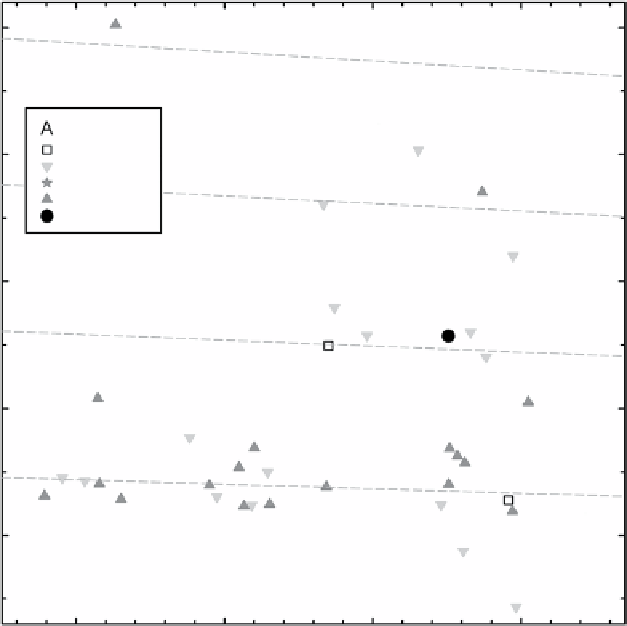Geology Reference
In-Depth Information
Dho 733
0.7
Feldspathic lunar meteorites
Ab
6
ANSMET
¥
MIL 090036
NWA 7022
NIPR
Africa
0.6
Australia
Oman
Apollo16 soil
Dho 1627
Kalahari 008
Ab
5
NWA 4936 et al.
0.5
Ab
4
0.4
¢
$
£
G
I
L
M
P
Ab
3
0.3
A
3
4
5
6
FeO
T
(%)
Figure 6.18.
Whole-rock Na
2
O concentrations in feldspathic lunar meteorites reflect the average albite (Ab) content of the plagio-
clase. Most feldspathic lunar meteorites have Na
2
O concentrations corresponding to plagioclase of about Ab
97
composition, but
some are more albitic. MIL 090036 is substantially richer in Na
2
O than all other ANSMET lunar meteorites.
concentrations of incompatible elements. Curiously,
although a number of the feldspathic lunar meteorites
from hot deserts have been identified as impact-melt or
granulitic breccias [e.g.,
Daubar et al
., 2002;
Hudgins
et al
., 2011;
Kuehner et al
., 2010;
Korotev
, 2012], all of the
brecciated ANSMET lunar meteorites are regolith
breccias.
Nearly two thirds (64%) of the ANSMET lunar mete-
orites are breccias from the feldspathic highlands. Until
lunar meteorites were discovered, most of our knowledge
of the composition, mineralogy, and petrography of the
feldspathic highlands was based on samples from the
Apollo
16 landing site. It was recognized at the time of
the mission (April 1972) that the site geology had been
influenced by the impact that formed the giant Imbrium
basin (Figure 6.2), centered 1650 km to the northwest
[
Muehlberger et al
., 1980]. During the decade following
the mission, however, the extent to which the Imbrium
impact had affected the chemical composition of mate-
rials from the
Apollo
16 landing site was largely unappre-
ciated. Mafic (noritic and troctolitic), KREEP-bearing
impact-melt breccias were common at the site, but
because such breccias were also found at the
Apollo
12,
14, 15, and 17 sites, it was assumed that such breccias
were characteristic of the highlands [
Ryder and Wood
,
1977;
Spudis
, 1984]. Results from the
Apollo
orbiting
gamma-ray spectrometers, however, showed that the
Imbrium-Procellarum area was rich in Th (3-5 µg/g),
whereas vast regions of the farside highlands were in the
0.3-0.5 µg/g range [
Metzger et al
., 1977], much lower
than the 2-2.5 µg/g characteristic of the
Apollo
16 site
(Figure 6.19). Thus, the low concentration of Th in the
first lunar meteorite (0.3 µg/g, ALH A81005, Figure 6.19)
led to immediate speculation that its point of origin was
distant from the Imbrium-Procellarum area [
Kallemeyn
and Warren
, 1983;
Korotev et al
., 1983]. Most of the feld-
spathic lunar meteorites found after ALH A81005 have
lower concentrations of Th and other incompatible
elements than does the
Apollo
16 regolith (Figures 6.4
and 6.19).
Among ANSMET meteorites, only MIL 090036 is
comparable to the
Apollo
16 regolith in concentrations
of incompatible elements; thus, it is likely to originate
from some place in the feldspathic highlands near
the Procellarum KREEP Terrane. By the time of MAC
88104/5, the fourth feldspathic meteorite, it was clear that

